Target Variables and Survey Questionnaire for IT Professionals' Current Uses of and Attitudes Towards Social Media
VerifiedAdded on 2022/11/18
|11
|2477
|172
AI Summary
This article discusses the target variables and survey questionnaire for IT professionals' current uses of and attitudes towards social media. It includes a survey questionnaire and ways of ensuring validity and reliability. The article also covers best practices and considerations when developing a survey, recruitment of participants, and required sample size.
Contribute Materials
Your contribution can guide someone’s learning journey. Share your
documents today.
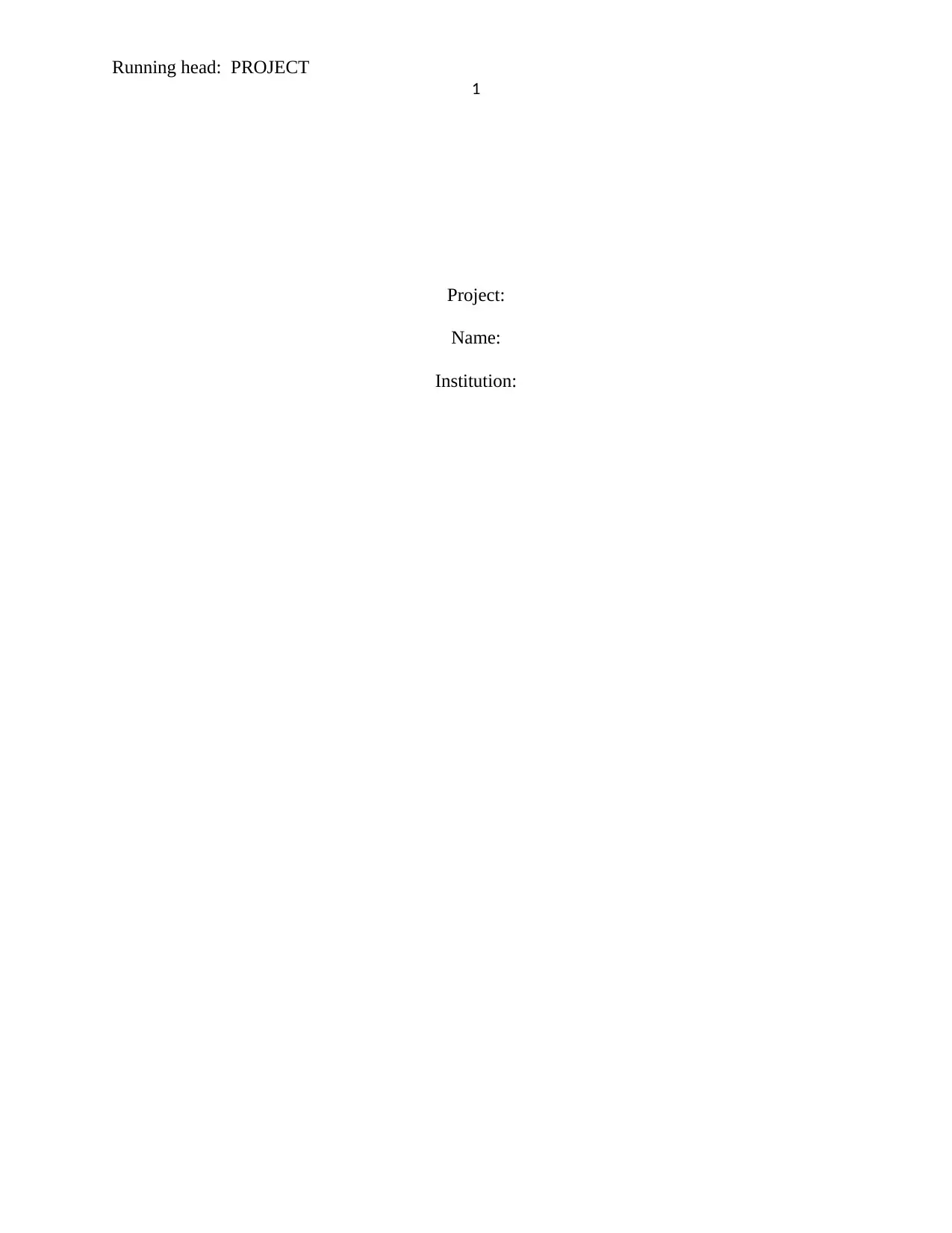
Running head: PROJECT
1
Project:
Name:
Institution:
1
Project:
Name:
Institution:
Secure Best Marks with AI Grader
Need help grading? Try our AI Grader for instant feedback on your assignments.
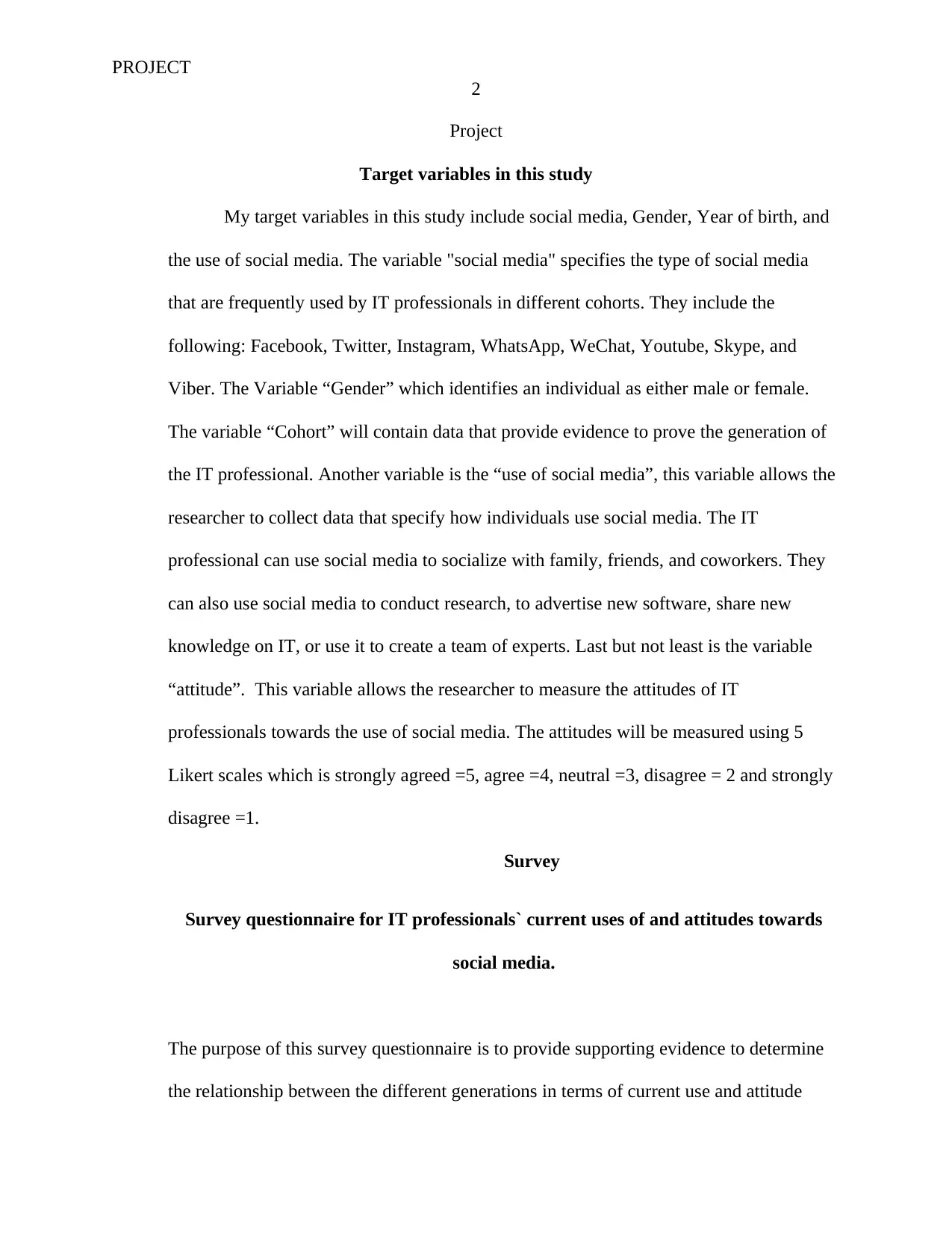
PROJECT
2
Project
Target variables in this study
My target variables in this study include social media, Gender, Year of birth, and
the use of social media. The variable "social media" specifies the type of social media
that are frequently used by IT professionals in different cohorts. They include the
following: Facebook, Twitter, Instagram, WhatsApp, WeChat, Youtube, Skype, and
Viber. The Variable “Gender” which identifies an individual as either male or female.
The variable “Cohort” will contain data that provide evidence to prove the generation of
the IT professional. Another variable is the “use of social media”, this variable allows the
researcher to collect data that specify how individuals use social media. The IT
professional can use social media to socialize with family, friends, and coworkers. They
can also use social media to conduct research, to advertise new software, share new
knowledge on IT, or use it to create a team of experts. Last but not least is the variable
“attitude”. This variable allows the researcher to measure the attitudes of IT
professionals towards the use of social media. The attitudes will be measured using 5
Likert scales which is strongly agreed =5, agree =4, neutral =3, disagree = 2 and strongly
disagree =1.
Survey
Survey questionnaire for IT professionals` current uses of and attitudes towards
social media.
The purpose of this survey questionnaire is to provide supporting evidence to determine
the relationship between the different generations in terms of current use and attitude
2
Project
Target variables in this study
My target variables in this study include social media, Gender, Year of birth, and
the use of social media. The variable "social media" specifies the type of social media
that are frequently used by IT professionals in different cohorts. They include the
following: Facebook, Twitter, Instagram, WhatsApp, WeChat, Youtube, Skype, and
Viber. The Variable “Gender” which identifies an individual as either male or female.
The variable “Cohort” will contain data that provide evidence to prove the generation of
the IT professional. Another variable is the “use of social media”, this variable allows the
researcher to collect data that specify how individuals use social media. The IT
professional can use social media to socialize with family, friends, and coworkers. They
can also use social media to conduct research, to advertise new software, share new
knowledge on IT, or use it to create a team of experts. Last but not least is the variable
“attitude”. This variable allows the researcher to measure the attitudes of IT
professionals towards the use of social media. The attitudes will be measured using 5
Likert scales which is strongly agreed =5, agree =4, neutral =3, disagree = 2 and strongly
disagree =1.
Survey
Survey questionnaire for IT professionals` current uses of and attitudes towards
social media.
The purpose of this survey questionnaire is to provide supporting evidence to determine
the relationship between the different generations in terms of current use and attitude
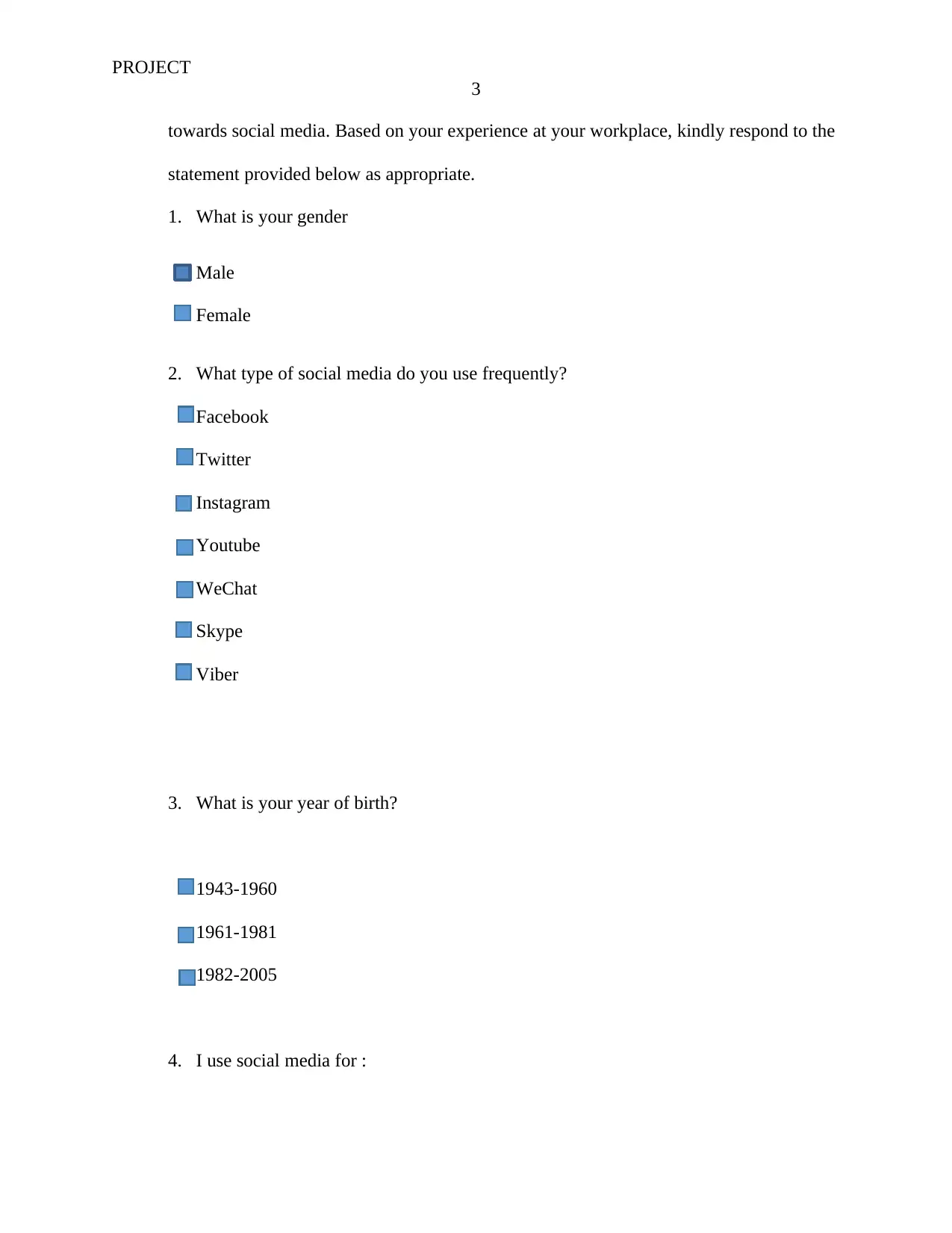
PROJECT
3
towards social media. Based on your experience at your workplace, kindly respond to the
statement provided below as appropriate.
1. What is your gender
Male
Female
2. What type of social media do you use frequently?
Facebook
Twitter
Instagram
Youtube
WeChat
Skype
Viber
3. What is your year of birth?
1943-1960
1961-1981
1982-2005
4. I use social media for :
3
towards social media. Based on your experience at your workplace, kindly respond to the
statement provided below as appropriate.
1. What is your gender
Male
Female
2. What type of social media do you use frequently?
Youtube
Skype
Viber
3. What is your year of birth?
1943-1960
1961-1981
1982-2005
4. I use social media for :
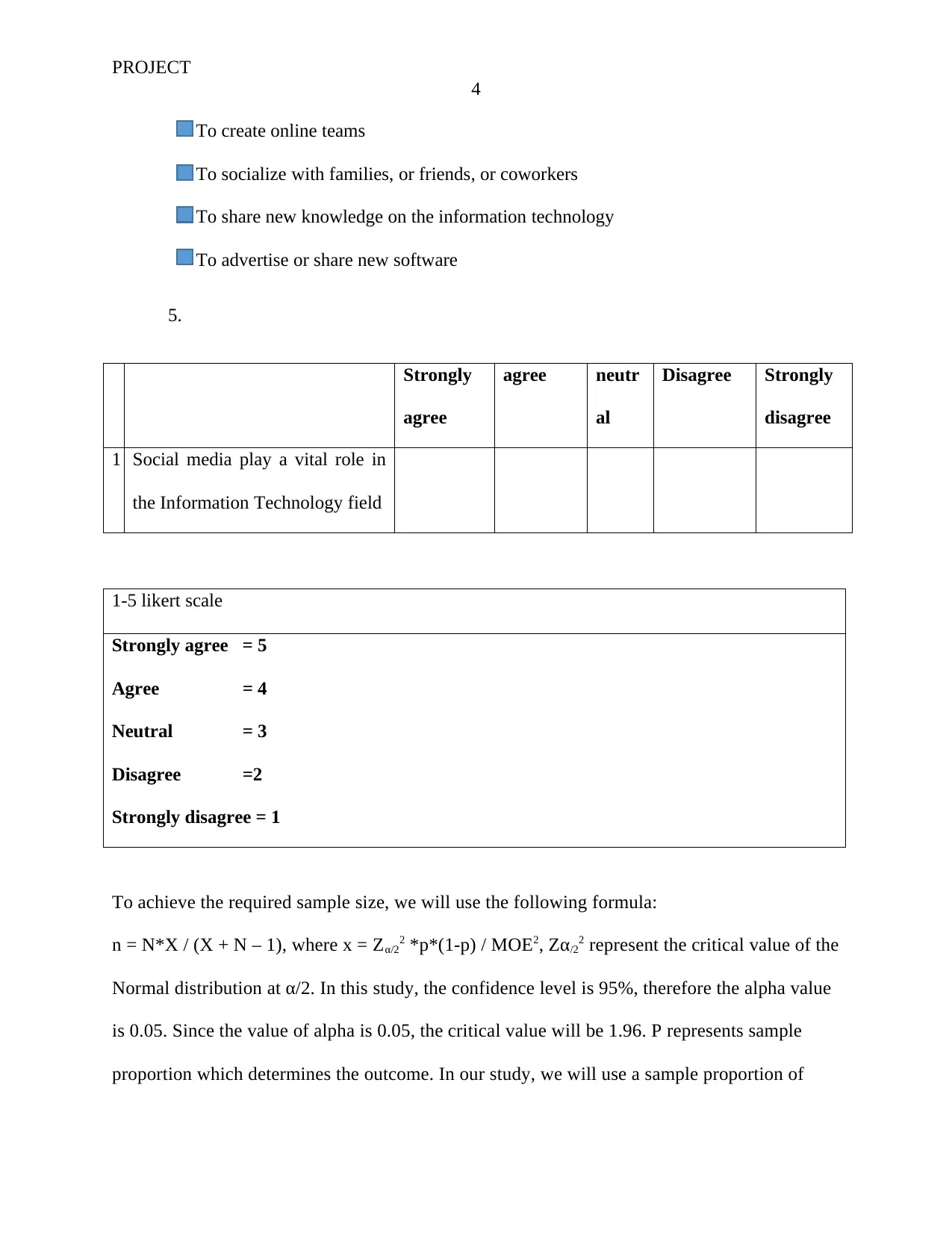
PROJECT
4
To create online teams
To socialize with families, or friends, or coworkers
To share new knowledge on the information technology
To advertise or share new software
5.
Strongly
agree
agree neutr
al
Disagree Strongly
disagree
1 Social media play a vital role in
the Information Technology field
1-5 likert scale
Strongly agree = 5
Agree = 4
Neutral = 3
Disagree =2
Strongly disagree = 1
To achieve the required sample size, we will use the following formula:
n = N*X / (X + N – 1), where x = Zα/22 *p*(1-p) / MOE2, Zα/22 represent the critical value of the
Normal distribution at α/2. In this study, the confidence level is 95%, therefore the alpha value
is 0.05. Since the value of alpha is 0.05, the critical value will be 1.96. P represents sample
proportion which determines the outcome. In our study, we will use a sample proportion of
4
To create online teams
To socialize with families, or friends, or coworkers
To share new knowledge on the information technology
To advertise or share new software
5.
Strongly
agree
agree neutr
al
Disagree Strongly
disagree
1 Social media play a vital role in
the Information Technology field
1-5 likert scale
Strongly agree = 5
Agree = 4
Neutral = 3
Disagree =2
Strongly disagree = 1
To achieve the required sample size, we will use the following formula:
n = N*X / (X + N – 1), where x = Zα/22 *p*(1-p) / MOE2, Zα/22 represent the critical value of the
Normal distribution at α/2. In this study, the confidence level is 95%, therefore the alpha value
is 0.05. Since the value of alpha is 0.05, the critical value will be 1.96. P represents sample
proportion which determines the outcome. In our study, we will use a sample proportion of
Secure Best Marks with AI Grader
Need help grading? Try our AI Grader for instant feedback on your assignments.
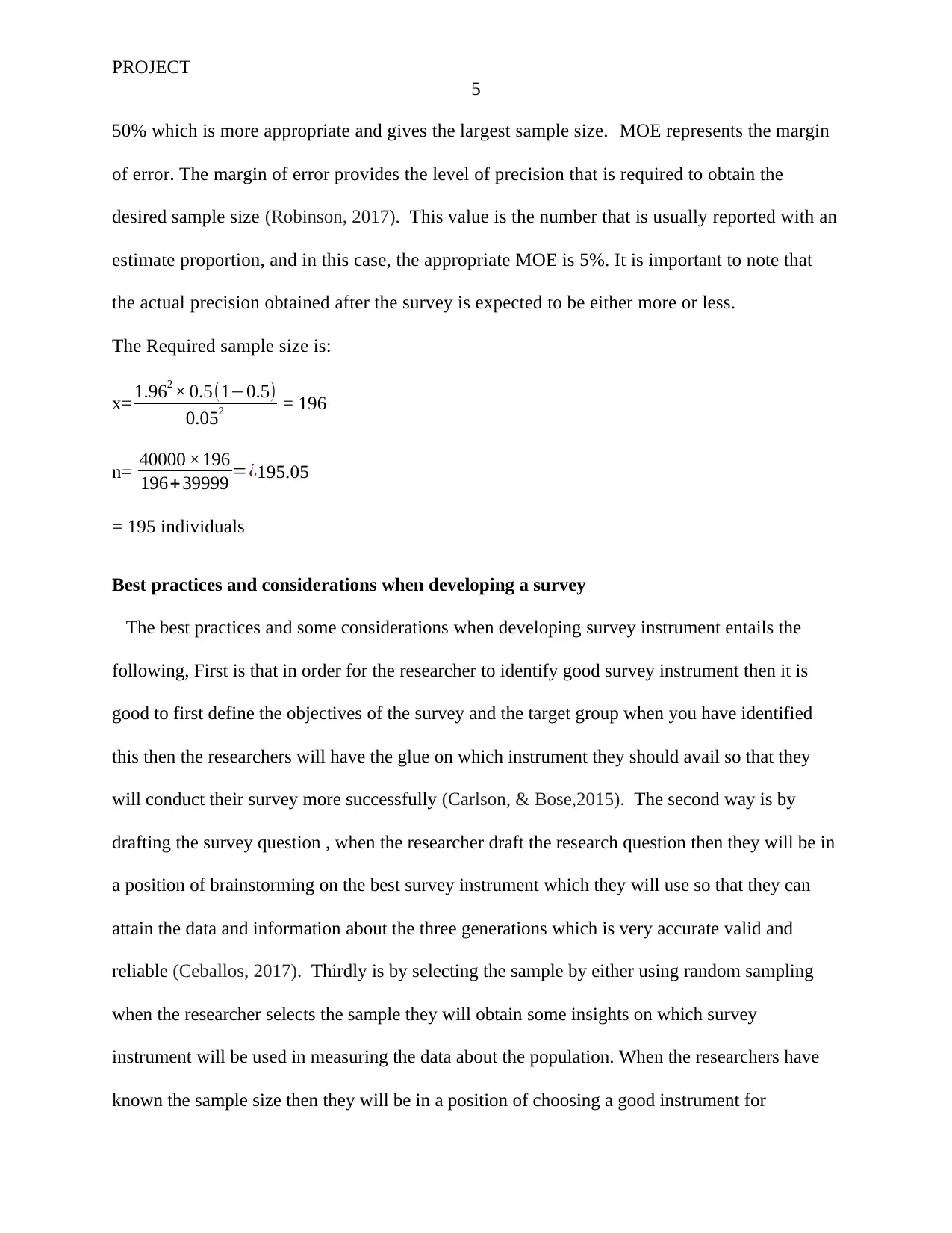
PROJECT
5
50% which is more appropriate and gives the largest sample size. MOE represents the margin
of error. The margin of error provides the level of precision that is required to obtain the
desired sample size (Robinson, 2017). This value is the number that is usually reported with an
estimate proportion, and in this case, the appropriate MOE is 5%. It is important to note that
the actual precision obtained after the survey is expected to be either more or less.
The Required sample size is:
x= 1.962 × 0.5(1−0.5)
0.052 = 196
n= 40000 ×196
196+39999 =¿195.05
= 195 individuals
Best practices and considerations when developing a survey
The best practices and some considerations when developing survey instrument entails the
following, First is that in order for the researcher to identify good survey instrument then it is
good to first define the objectives of the survey and the target group when you have identified
this then the researchers will have the glue on which instrument they should avail so that they
will conduct their survey more successfully (Carlson, & Bose,2015). The second way is by
drafting the survey question , when the researcher draft the research question then they will be in
a position of brainstorming on the best survey instrument which they will use so that they can
attain the data and information about the three generations which is very accurate valid and
reliable (Ceballos, 2017). Thirdly is by selecting the sample by either using random sampling
when the researcher selects the sample they will obtain some insights on which survey
instrument will be used in measuring the data about the population. When the researchers have
known the sample size then they will be in a position of choosing a good instrument for
5
50% which is more appropriate and gives the largest sample size. MOE represents the margin
of error. The margin of error provides the level of precision that is required to obtain the
desired sample size (Robinson, 2017). This value is the number that is usually reported with an
estimate proportion, and in this case, the appropriate MOE is 5%. It is important to note that
the actual precision obtained after the survey is expected to be either more or less.
The Required sample size is:
x= 1.962 × 0.5(1−0.5)
0.052 = 196
n= 40000 ×196
196+39999 =¿195.05
= 195 individuals
Best practices and considerations when developing a survey
The best practices and some considerations when developing survey instrument entails the
following, First is that in order for the researcher to identify good survey instrument then it is
good to first define the objectives of the survey and the target group when you have identified
this then the researchers will have the glue on which instrument they should avail so that they
will conduct their survey more successfully (Carlson, & Bose,2015). The second way is by
drafting the survey question , when the researcher draft the research question then they will be in
a position of brainstorming on the best survey instrument which they will use so that they can
attain the data and information about the three generations which is very accurate valid and
reliable (Ceballos, 2017). Thirdly is by selecting the sample by either using random sampling
when the researcher selects the sample they will obtain some insights on which survey
instrument will be used in measuring the data about the population. When the researchers have
known the sample size then they will be in a position of choosing a good instrument for
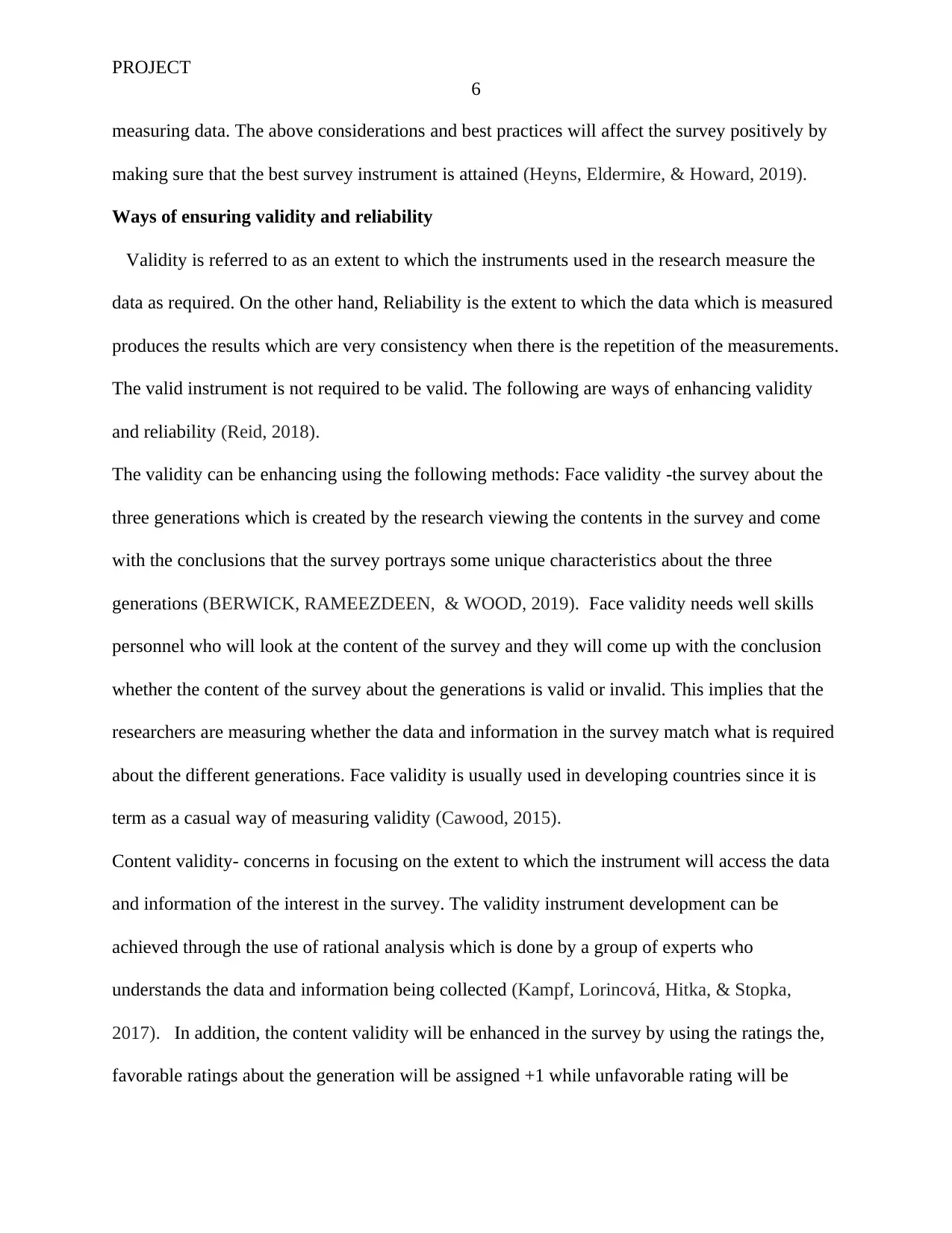
PROJECT
6
measuring data. The above considerations and best practices will affect the survey positively by
making sure that the best survey instrument is attained (Heyns, Eldermire, & Howard, 2019).
Ways of ensuring validity and reliability
Validity is referred to as an extent to which the instruments used in the research measure the
data as required. On the other hand, Reliability is the extent to which the data which is measured
produces the results which are very consistency when there is the repetition of the measurements.
The valid instrument is not required to be valid. The following are ways of enhancing validity
and reliability (Reid, 2018).
The validity can be enhancing using the following methods: Face validity -the survey about the
three generations which is created by the research viewing the contents in the survey and come
with the conclusions that the survey portrays some unique characteristics about the three
generations (BERWICK, RAMEEZDEEN, & WOOD, 2019). Face validity needs well skills
personnel who will look at the content of the survey and they will come up with the conclusion
whether the content of the survey about the generations is valid or invalid. This implies that the
researchers are measuring whether the data and information in the survey match what is required
about the different generations. Face validity is usually used in developing countries since it is
term as a casual way of measuring validity (Cawood, 2015).
Content validity- concerns in focusing on the extent to which the instrument will access the data
and information of the interest in the survey. The validity instrument development can be
achieved through the use of rational analysis which is done by a group of experts who
understands the data and information being collected (Kampf, Lorincová, Hitka, & Stopka,
2017). In addition, the content validity will be enhanced in the survey by using the ratings the,
favorable ratings about the generation will be assigned +1 while unfavorable rating will be
6
measuring data. The above considerations and best practices will affect the survey positively by
making sure that the best survey instrument is attained (Heyns, Eldermire, & Howard, 2019).
Ways of ensuring validity and reliability
Validity is referred to as an extent to which the instruments used in the research measure the
data as required. On the other hand, Reliability is the extent to which the data which is measured
produces the results which are very consistency when there is the repetition of the measurements.
The valid instrument is not required to be valid. The following are ways of enhancing validity
and reliability (Reid, 2018).
The validity can be enhancing using the following methods: Face validity -the survey about the
three generations which is created by the research viewing the contents in the survey and come
with the conclusions that the survey portrays some unique characteristics about the three
generations (BERWICK, RAMEEZDEEN, & WOOD, 2019). Face validity needs well skills
personnel who will look at the content of the survey and they will come up with the conclusion
whether the content of the survey about the generations is valid or invalid. This implies that the
researchers are measuring whether the data and information in the survey match what is required
about the different generations. Face validity is usually used in developing countries since it is
term as a casual way of measuring validity (Cawood, 2015).
Content validity- concerns in focusing on the extent to which the instrument will access the data
and information of the interest in the survey. The validity instrument development can be
achieved through the use of rational analysis which is done by a group of experts who
understands the data and information being collected (Kampf, Lorincová, Hitka, & Stopka,
2017). In addition, the content validity will be enhanced in the survey by using the ratings the,
favorable ratings about the generation will be assigned +1 while unfavorable rating will be
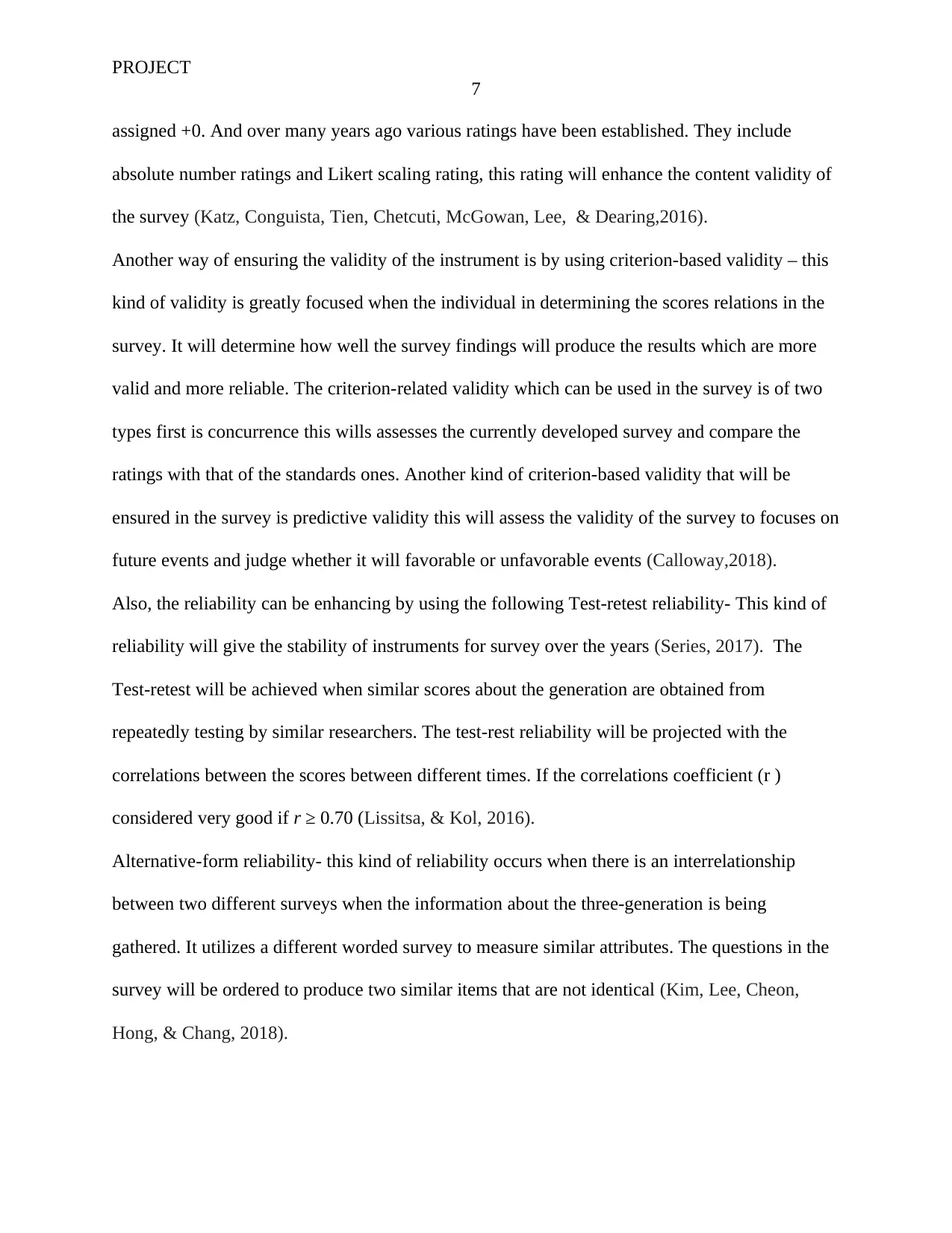
PROJECT
7
assigned +0. And over many years ago various ratings have been established. They include
absolute number ratings and Likert scaling rating, this rating will enhance the content validity of
the survey (Katz, Conguista, Tien, Chetcuti, McGowan, Lee, & Dearing,2016).
Another way of ensuring the validity of the instrument is by using criterion-based validity – this
kind of validity is greatly focused when the individual in determining the scores relations in the
survey. It will determine how well the survey findings will produce the results which are more
valid and more reliable. The criterion-related validity which can be used in the survey is of two
types first is concurrence this wills assesses the currently developed survey and compare the
ratings with that of the standards ones. Another kind of criterion-based validity that will be
ensured in the survey is predictive validity this will assess the validity of the survey to focuses on
future events and judge whether it will favorable or unfavorable events (Calloway,2018).
Also, the reliability can be enhancing by using the following Test-retest reliability- This kind of
reliability will give the stability of instruments for survey over the years (Series, 2017). The
Test-retest will be achieved when similar scores about the generation are obtained from
repeatedly testing by similar researchers. The test-rest reliability will be projected with the
correlations between the scores between different times. If the correlations coefficient (r )
considered very good if r ≥ 0.70 (Lissitsa, & Kol, 2016).
Alternative-form reliability- this kind of reliability occurs when there is an interrelationship
between two different surveys when the information about the three-generation is being
gathered. It utilizes a different worded survey to measure similar attributes. The questions in the
survey will be ordered to produce two similar items that are not identical (Kim, Lee, Cheon,
Hong, & Chang, 2018).
7
assigned +0. And over many years ago various ratings have been established. They include
absolute number ratings and Likert scaling rating, this rating will enhance the content validity of
the survey (Katz, Conguista, Tien, Chetcuti, McGowan, Lee, & Dearing,2016).
Another way of ensuring the validity of the instrument is by using criterion-based validity – this
kind of validity is greatly focused when the individual in determining the scores relations in the
survey. It will determine how well the survey findings will produce the results which are more
valid and more reliable. The criterion-related validity which can be used in the survey is of two
types first is concurrence this wills assesses the currently developed survey and compare the
ratings with that of the standards ones. Another kind of criterion-based validity that will be
ensured in the survey is predictive validity this will assess the validity of the survey to focuses on
future events and judge whether it will favorable or unfavorable events (Calloway,2018).
Also, the reliability can be enhancing by using the following Test-retest reliability- This kind of
reliability will give the stability of instruments for survey over the years (Series, 2017). The
Test-retest will be achieved when similar scores about the generation are obtained from
repeatedly testing by similar researchers. The test-rest reliability will be projected with the
correlations between the scores between different times. If the correlations coefficient (r )
considered very good if r ≥ 0.70 (Lissitsa, & Kol, 2016).
Alternative-form reliability- this kind of reliability occurs when there is an interrelationship
between two different surveys when the information about the three-generation is being
gathered. It utilizes a different worded survey to measure similar attributes. The questions in the
survey will be ordered to produce two similar items that are not identical (Kim, Lee, Cheon,
Hong, & Chang, 2018).
Paraphrase This Document
Need a fresh take? Get an instant paraphrase of this document with our AI Paraphraser
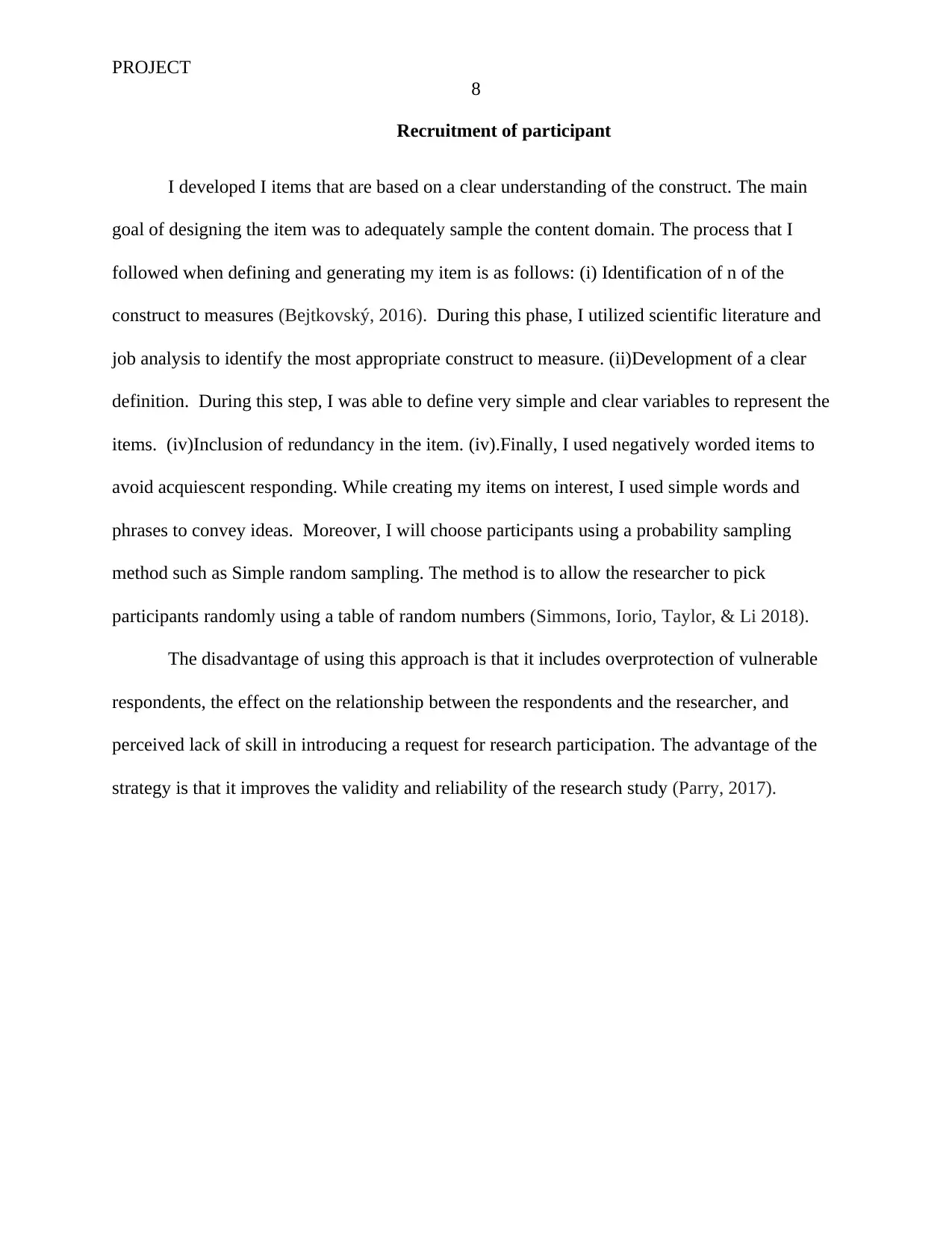
PROJECT
8
Recruitment of participant
I developed I items that are based on a clear understanding of the construct. The main
goal of designing the item was to adequately sample the content domain. The process that I
followed when defining and generating my item is as follows: (i) Identification of n of the
construct to measures (Bejtkovský, 2016). During this phase, I utilized scientific literature and
job analysis to identify the most appropriate construct to measure. (ii)Development of a clear
definition. During this step, I was able to define very simple and clear variables to represent the
items. (iv)Inclusion of redundancy in the item. (iv).Finally, I used negatively worded items to
avoid acquiescent responding. While creating my items on interest, I used simple words and
phrases to convey ideas. Moreover, I will choose participants using a probability sampling
method such as Simple random sampling. The method is to allow the researcher to pick
participants randomly using a table of random numbers (Simmons, Iorio, Taylor, & Li 2018).
The disadvantage of using this approach is that it includes overprotection of vulnerable
respondents, the effect on the relationship between the respondents and the researcher, and
perceived lack of skill in introducing a request for research participation. The advantage of the
strategy is that it improves the validity and reliability of the research study (Parry, 2017).
8
Recruitment of participant
I developed I items that are based on a clear understanding of the construct. The main
goal of designing the item was to adequately sample the content domain. The process that I
followed when defining and generating my item is as follows: (i) Identification of n of the
construct to measures (Bejtkovský, 2016). During this phase, I utilized scientific literature and
job analysis to identify the most appropriate construct to measure. (ii)Development of a clear
definition. During this step, I was able to define very simple and clear variables to represent the
items. (iv)Inclusion of redundancy in the item. (iv).Finally, I used negatively worded items to
avoid acquiescent responding. While creating my items on interest, I used simple words and
phrases to convey ideas. Moreover, I will choose participants using a probability sampling
method such as Simple random sampling. The method is to allow the researcher to pick
participants randomly using a table of random numbers (Simmons, Iorio, Taylor, & Li 2018).
The disadvantage of using this approach is that it includes overprotection of vulnerable
respondents, the effect on the relationship between the respondents and the researcher, and
perceived lack of skill in introducing a request for research participation. The advantage of the
strategy is that it improves the validity and reliability of the research study (Parry, 2017).
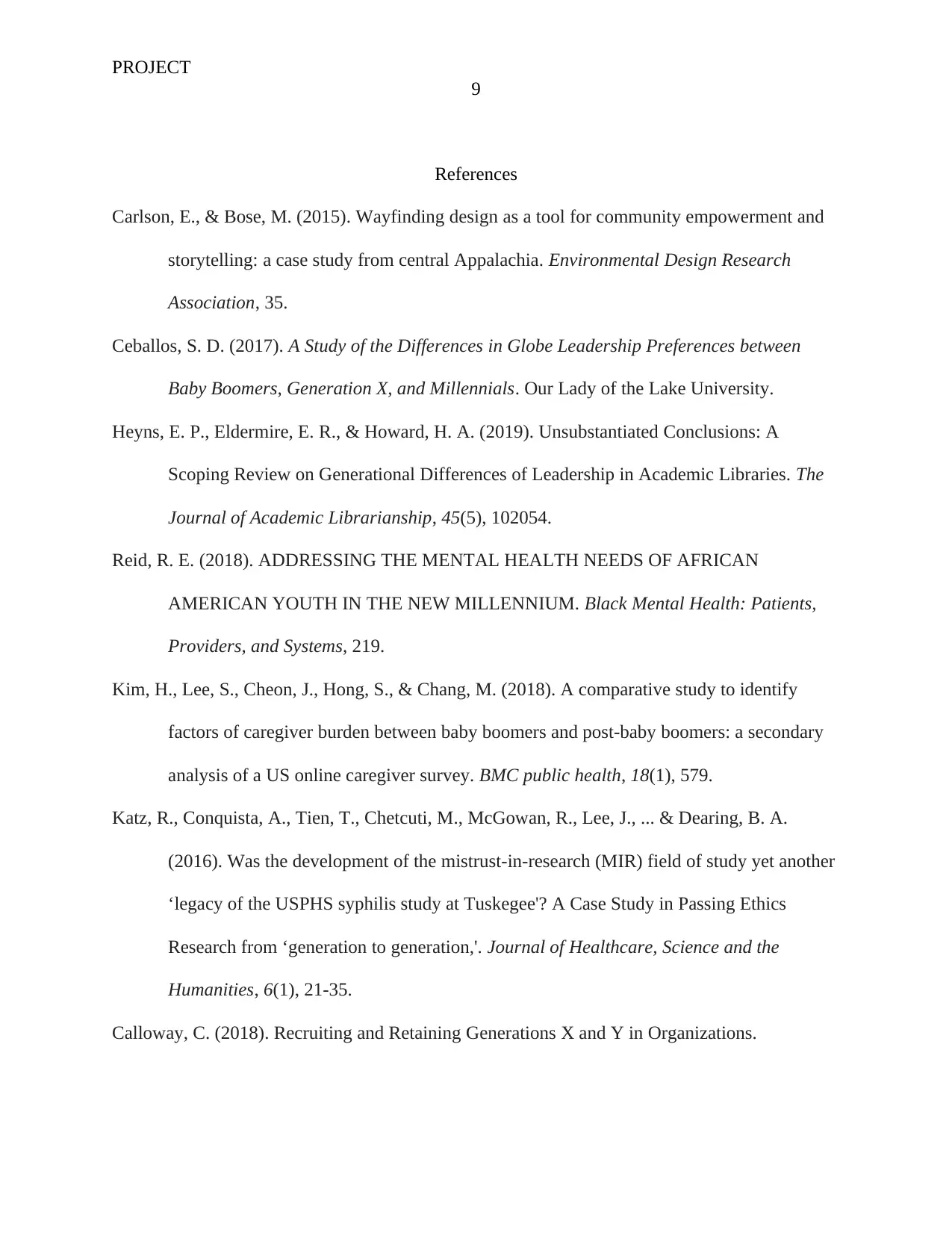
PROJECT
9
References
Carlson, E., & Bose, M. (2015). Wayfinding design as a tool for community empowerment and
storytelling: a case study from central Appalachia. Environmental Design Research
Association, 35.
Ceballos, S. D. (2017). A Study of the Differences in Globe Leadership Preferences between
Baby Boomers, Generation X, and Millennials. Our Lady of the Lake University.
Heyns, E. P., Eldermire, E. R., & Howard, H. A. (2019). Unsubstantiated Conclusions: A
Scoping Review on Generational Differences of Leadership in Academic Libraries. The
Journal of Academic Librarianship, 45(5), 102054.
Reid, R. E. (2018). ADDRESSING THE MENTAL HEALTH NEEDS OF AFRICAN
AMERICAN YOUTH IN THE NEW MILLENNIUM. Black Mental Health: Patients,
Providers, and Systems, 219.
Kim, H., Lee, S., Cheon, J., Hong, S., & Chang, M. (2018). A comparative study to identify
factors of caregiver burden between baby boomers and post-baby boomers: a secondary
analysis of a US online caregiver survey. BMC public health, 18(1), 579.
Katz, R., Conquista, A., Tien, T., Chetcuti, M., McGowan, R., Lee, J., ... & Dearing, B. A.
(2016). Was the development of the mistrust-in-research (MIR) field of study yet another
‘legacy of the USPHS syphilis study at Tuskegee'? A Case Study in Passing Ethics
Research from ‘generation to generation,'. Journal of Healthcare, Science and the
Humanities, 6(1), 21-35.
Calloway, C. (2018). Recruiting and Retaining Generations X and Y in Organizations.
9
References
Carlson, E., & Bose, M. (2015). Wayfinding design as a tool for community empowerment and
storytelling: a case study from central Appalachia. Environmental Design Research
Association, 35.
Ceballos, S. D. (2017). A Study of the Differences in Globe Leadership Preferences between
Baby Boomers, Generation X, and Millennials. Our Lady of the Lake University.
Heyns, E. P., Eldermire, E. R., & Howard, H. A. (2019). Unsubstantiated Conclusions: A
Scoping Review on Generational Differences of Leadership in Academic Libraries. The
Journal of Academic Librarianship, 45(5), 102054.
Reid, R. E. (2018). ADDRESSING THE MENTAL HEALTH NEEDS OF AFRICAN
AMERICAN YOUTH IN THE NEW MILLENNIUM. Black Mental Health: Patients,
Providers, and Systems, 219.
Kim, H., Lee, S., Cheon, J., Hong, S., & Chang, M. (2018). A comparative study to identify
factors of caregiver burden between baby boomers and post-baby boomers: a secondary
analysis of a US online caregiver survey. BMC public health, 18(1), 579.
Katz, R., Conquista, A., Tien, T., Chetcuti, M., McGowan, R., Lee, J., ... & Dearing, B. A.
(2016). Was the development of the mistrust-in-research (MIR) field of study yet another
‘legacy of the USPHS syphilis study at Tuskegee'? A Case Study in Passing Ethics
Research from ‘generation to generation,'. Journal of Healthcare, Science and the
Humanities, 6(1), 21-35.
Calloway, C. (2018). Recruiting and Retaining Generations X and Y in Organizations.
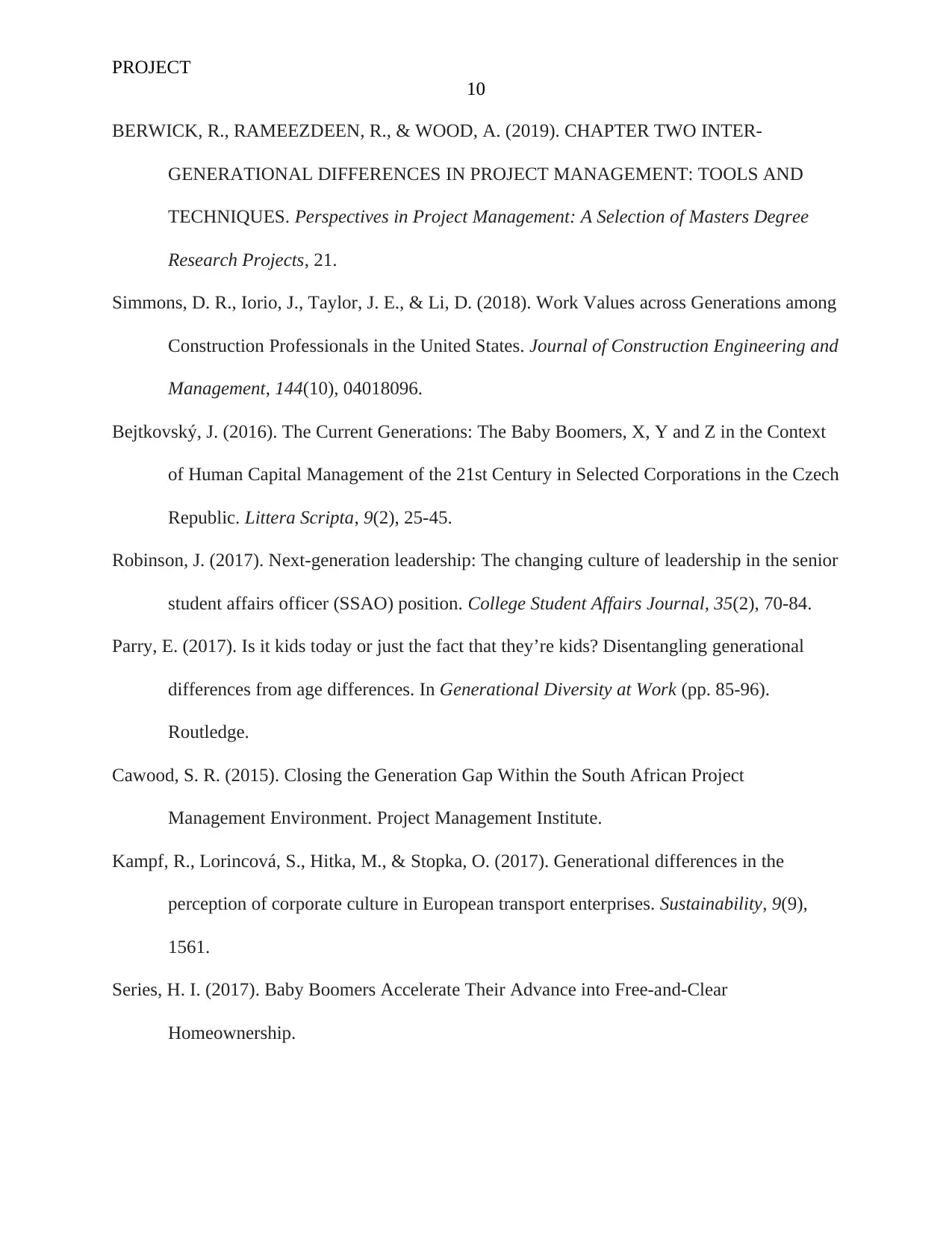
PROJECT
10
BERWICK, R., RAMEEZDEEN, R., & WOOD, A. (2019). CHAPTER TWO INTER-
GENERATIONAL DIFFERENCES IN PROJECT MANAGEMENT: TOOLS AND
TECHNIQUES. Perspectives in Project Management: A Selection of Masters Degree
Research Projects, 21.
Simmons, D. R., Iorio, J., Taylor, J. E., & Li, D. (2018). Work Values across Generations among
Construction Professionals in the United States. Journal of Construction Engineering and
Management, 144(10), 04018096.
Bejtkovský, J. (2016). The Current Generations: The Baby Boomers, X, Y and Z in the Context
of Human Capital Management of the 21st Century in Selected Corporations in the Czech
Republic. Littera Scripta, 9(2), 25-45.
Robinson, J. (2017). Next-generation leadership: The changing culture of leadership in the senior
student affairs officer (SSAO) position. College Student Affairs Journal, 35(2), 70-84.
Parry, E. (2017). Is it kids today or just the fact that they’re kids? Disentangling generational
differences from age differences. In Generational Diversity at Work (pp. 85-96).
Routledge.
Cawood, S. R. (2015). Closing the Generation Gap Within the South African Project
Management Environment. Project Management Institute.
Kampf, R., Lorincová, S., Hitka, M., & Stopka, O. (2017). Generational differences in the
perception of corporate culture in European transport enterprises. Sustainability, 9(9),
1561.
Series, H. I. (2017). Baby Boomers Accelerate Their Advance into Free-and-Clear
Homeownership.
10
BERWICK, R., RAMEEZDEEN, R., & WOOD, A. (2019). CHAPTER TWO INTER-
GENERATIONAL DIFFERENCES IN PROJECT MANAGEMENT: TOOLS AND
TECHNIQUES. Perspectives in Project Management: A Selection of Masters Degree
Research Projects, 21.
Simmons, D. R., Iorio, J., Taylor, J. E., & Li, D. (2018). Work Values across Generations among
Construction Professionals in the United States. Journal of Construction Engineering and
Management, 144(10), 04018096.
Bejtkovský, J. (2016). The Current Generations: The Baby Boomers, X, Y and Z in the Context
of Human Capital Management of the 21st Century in Selected Corporations in the Czech
Republic. Littera Scripta, 9(2), 25-45.
Robinson, J. (2017). Next-generation leadership: The changing culture of leadership in the senior
student affairs officer (SSAO) position. College Student Affairs Journal, 35(2), 70-84.
Parry, E. (2017). Is it kids today or just the fact that they’re kids? Disentangling generational
differences from age differences. In Generational Diversity at Work (pp. 85-96).
Routledge.
Cawood, S. R. (2015). Closing the Generation Gap Within the South African Project
Management Environment. Project Management Institute.
Kampf, R., Lorincová, S., Hitka, M., & Stopka, O. (2017). Generational differences in the
perception of corporate culture in European transport enterprises. Sustainability, 9(9),
1561.
Series, H. I. (2017). Baby Boomers Accelerate Their Advance into Free-and-Clear
Homeownership.
Secure Best Marks with AI Grader
Need help grading? Try our AI Grader for instant feedback on your assignments.
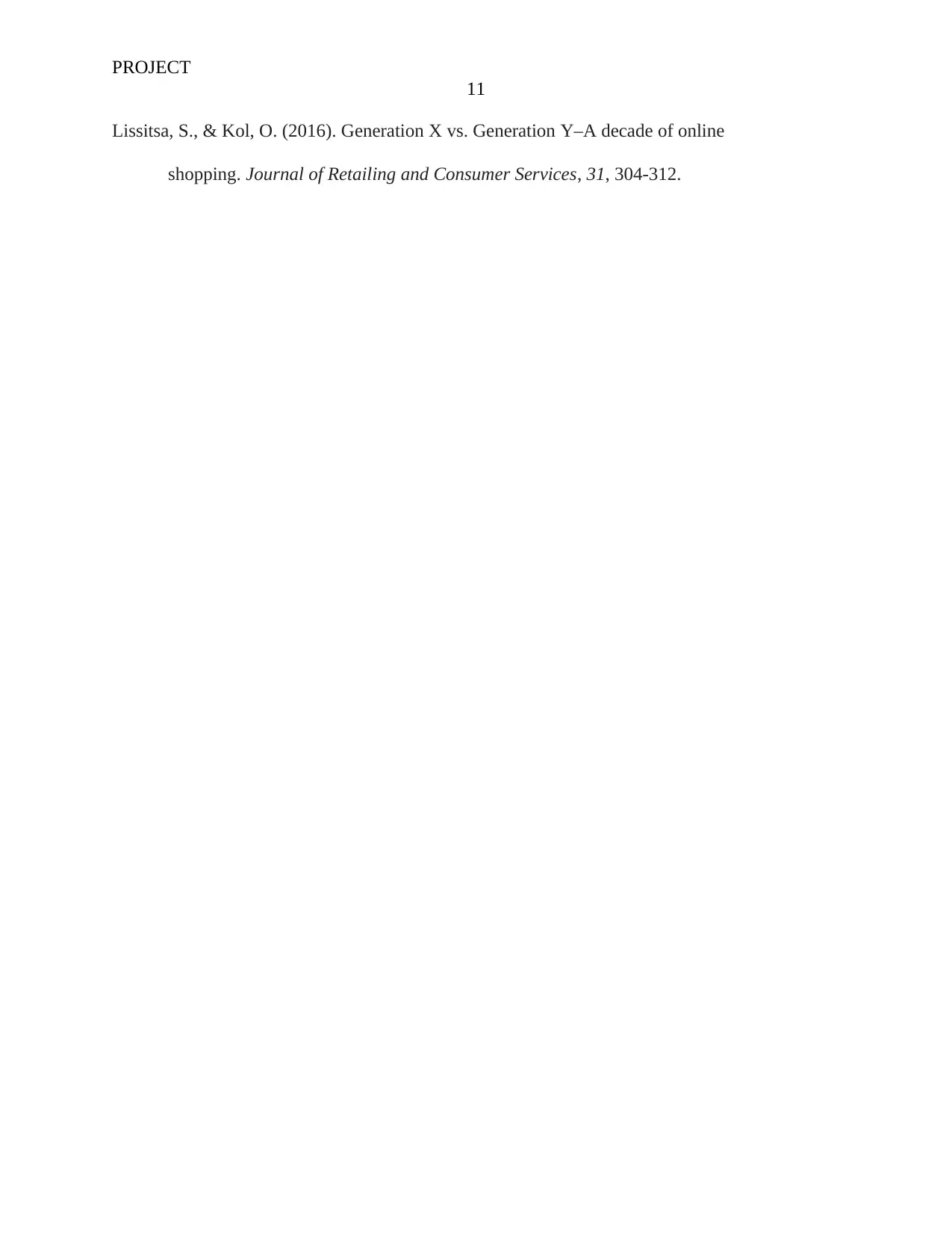
PROJECT
11
Lissitsa, S., & Kol, O. (2016). Generation X vs. Generation Y–A decade of online
shopping. Journal of Retailing and Consumer Services, 31, 304-312.
11
Lissitsa, S., & Kol, O. (2016). Generation X vs. Generation Y–A decade of online
shopping. Journal of Retailing and Consumer Services, 31, 304-312.
1 out of 11
Your All-in-One AI-Powered Toolkit for Academic Success.
+13062052269
info@desklib.com
Available 24*7 on WhatsApp / Email
![[object Object]](/_next/static/media/star-bottom.7253800d.svg)
Unlock your academic potential
© 2024 | Zucol Services PVT LTD | All rights reserved.